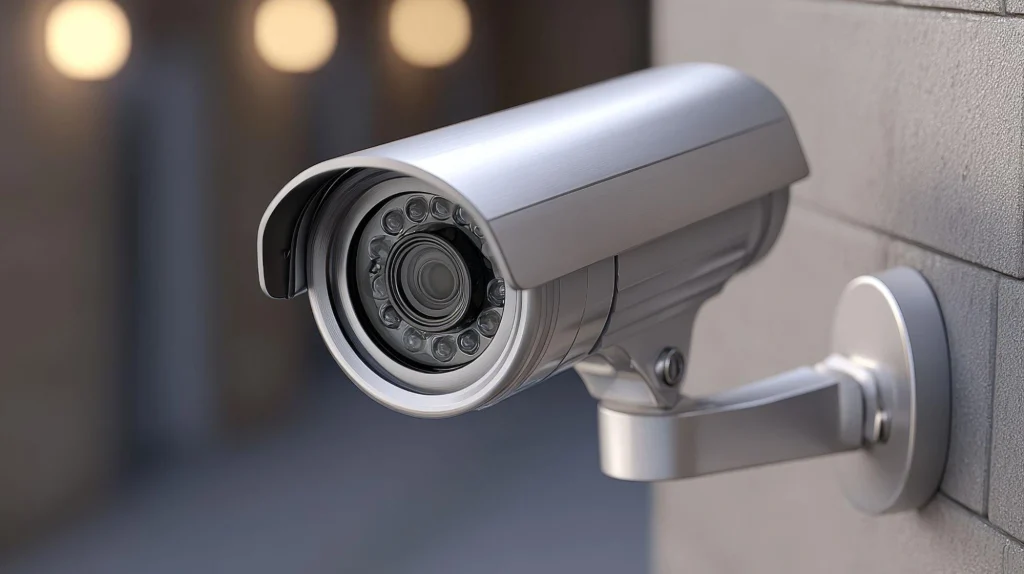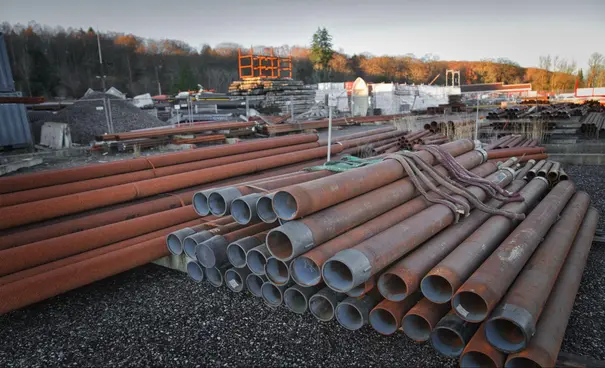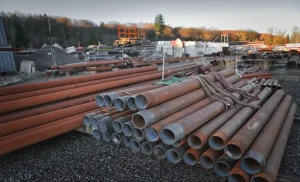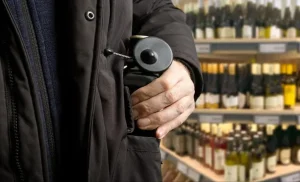Metal theft racks up millions of dollars in losses every year. Copper is a top target; it is often stolen from wiring, plumbing, and catalytic converters. Aluminum, brass, steel, and iron are also common materials, often sourced from window frames, ladders, manhole covers, grates, and fencing. It’s amusing how the very things you install for security often end up being what thieves take first.
Even precious metals like platinum, palladium, and rhodium, which are often found in catalytic converters, are on the radar of thieves. In short, criminals are walking away with just about anything made of metal.
Metal theft poses a significant risk to your business. Strong laws and smart prevention can keep your projects and infrastructure safe. This blog explains how.
What is metal theft?
Metal theft is the illegal removal and resale of metal from homes, businesses, vehicles, and critical infrastructure. Thieves target valuable materials, such as copper wiring, aluminum siding, or catalytic converters, often selling them to scrap yards for quick cash.
How does metal theft risk your business?
Metal theft isn’t just about a few missing screws or stolen power tools. It can bring entire projects to a standstill. When thieves strip copper wiring or remove critical components, such as transformers, cables, or structural steel, the damage ripples far beyond the loss of materials.
Power outages delay inspections, halt construction, push back delivery timelines. Repairing the damage drains budgets that were never meant to cover theft.
A single incident can disrupt months of planning, compromise worker safety, and leave sites vulnerable to additional security risks. This is just one example of a construction site; in industries such as warehouses, condos, residential buildings, et public infrastructure, metal theft is even more disastrous. Metal theft isn’t a petty crime; it’s a project killer.
How do metal thieves steal?
Thieves use basic tools to strip wires, cut pipes, and remove fixtures. They may steal directly from active sites or return repeatedly to abandoned or unsecured properties.
Even dumpster divers can go beyond trash, swiping small metal parts they can sell for quick cash. Organized retail crime groups take it further, targeting high-value materials like copper, brass, and convertisseurs catalytiques to resell through scrap yards or underground markets.
What are the metal theft laws?

Metal theft laws protect communities and businesses from costly losses by regulating the sale and handling of stolen metals.
Examples:
- California AB 476 (2025): Requires recyclers to verify seller identities, keep transaction records, and report suspicious activity to prevent copper wire theft.
- Ohio HB 328 (2025): Strengthens penalties for catalytic converter theft and mandates stricter scrap dealer record-keeping.
- Texas Chapter 1956: Requires ID checks, proof of ownership, and a 72-hour waiting period for certain metal sales.
These laws make it more difficult for thieves to profit and provide law enforcement with the tools to trace stolen metal and protect infrastructure.
But despite these metal theft laws, hotspots for metal theft continue to emerge across the U.S.
Common targets of metal theft:
To combat metal theft effectively, you first need to understand the various forms it can take. Thieves are ready to walk away with almost anything that they can get good money for. Utility companies and police task forces share some scary data on Copper theft from power grids, substations, and telecom lines.
Latest metal theft news and trends in the U.S. 2025:
Texas, la Californie, et Ohio are among the states hardest hit by metal theft.
In Texas, police in Dallas and Houston reported multiple thefts of copper grounding wire from electrical substations, causing blackouts in several neighborhoods.
AT&T and PG&E reported thousands of feet of communication cable stolen from underground lines, disrupting internet and 911 services in some rural counties.
Construction and warehouse theft spikes:
Law enforcement in Floride, Nevada, and Michigan has noted a sharp increase in thefts from commis sur les chantiers and industrial warehouses.
Police arrested a crew stealing copper pipes and metal beams from a warehouse in Detroit that was under renovation, with estimated losses exceeding $250,000.
Las Vegas construction companies reported thefts of copper wiring, HVAC units, and aluminum scaffolding from job sites overnight.
Catalytic converter thefts are still common:
Despite new state laws, catalytic converter theft remains a major issue across the country.
California, Illinois, and New York continue to lead in reported cases.
La FBI’s 2024 report noted over 100,000 incidents nationwide last year, with organized crime groups linked to illegal exports of stolen converters.
Some states now require auto shops to mark converter serial numbers and track transactions to prevent resale.
Copper theft in residential and small business targets:
Vacant homes, rental properties, and small workshops are frequent targets.
In Oklahoma, three men were arrested in McClain County after thousands of feet of copper wire were stolen from cell towers, while residents in north Tulsa reported that streetlights were out due to theft.
Law enforcement in Maryland, Delaware, and Indiana has also made multiple arrests, while in Texas, a man was caught after selling more than 4,000 pounds of stolen copper.
These incidents demonstrate the impact of copper theft on everyday life, affecting everything from safety and lighting to business operations.
Metal theft is big, and to fight it you need tried and tested theft prevention tools and techniques:
Metal theft prevention: tools, tactics, and policies:

1) Lock it down with strong physical security (lowest tech, high impact):
Perimeter control:
Perimeter control is one of the most effective ways to prevent metal theft. A strong fence, locked gates, and secure enclosures make it harder for thieves to get in. When access isn’t easy, most won’t even try, And if they do, you gain valuable time to respond. We have high quality blogs to help you understand better:
- L'utilité des alarmes périmétriques pour les immeubles commerciaux.
- Caméra thermique de sécurité : 3 raisons pour une sécurité périmétrique optimale.
- des 7 meilleures solutions de sécurité du périmètre pour les entreprises : tout ce que vous devez savoir.
Lighting and visibility:
Bright, motion-activated exterior lighting is the simplest yet most effective theft deterrent. Lights remove hiding spots, make it harder for thieves to move unnoticed, and give cameras a clear view for evidence. A well-lit site isn’t just safer ,it’s harder to target and improve camera footage.
Good read: Construction site lighting requirement
Layered barriers:
Layered barriers make theft harder, noisier, and riskier. By bolting down manhole covers, locking transformer cages, and securing HVAC coils, you block easy grab-and-go theft.
2) Watch it in real time with video and active monitoring(detect, verify, respond):
Surveillance par télévision en circuit fermé :

CCTV surveillance for metal theft isn’t just about catching criminals after the fact; it’s about stopping trouble before it gets worse. Good camera placement, fast response, and solid evidence make CCTV one of the most effective ways to protect your site and keep projects on track.
Bonnes lectures :
- Avantages et inconvénients de l'autosurveillance par rapport à la vidéosurveillance professionnelle.
- Qu'est-ce que la vidéosurveillance et comment fonctionne-t-elle ??
Smart analytics:
Cameras with de fonctions d'analyse vidéo avancées can detect suspicious movement in real-time, even when no one’s on site. Motion classification, line crossing, and noisy tool detection reduce false alarms and expedite action.
Surveillance vidéo à distance :

Lorsque le Caméras à IA are integrated with surveillance vidéo à distance alimentée par l'IA, the alarms are triggered at the remote operating center. The trained operators access live video feeds and can verify what’s happening. The remote operators intervene via live audio interventions or play recorded warnings, notifying on-site security or the police immediately as per SOPs.
This rapid response transforms a passive camera system into an active shield, reducing the risk of repeat strikes and costly damage.
3) Asset hardening and vehicle protection:
Asset marking:
Asset marking is one of the simplest and most effective ways to prevent metal theft. By permanently marking or painting pipes, cables, and equipment with your company ID, you make stolen materials harder to resell and easier to trace.
Thieves look for quick cash, and anything that slows them down makes your site a less attractive target. Clear, durable markings also give law enforcement a better chance of recovering what has been taken.
Tamper-resistant fittings:
Tamper-resistant fittings make it much harder for thieves to get what they want. By using armored conduit, cut-resistant sleeves, and lockable cages around wiring and transformers, you turn quick theft into a noisy, time-consuming job most criminals will avoid.
These simple upgrades protect critical systems from being compromised, prevent costly power outages, and provide visible proof if someone attempts to break in. A few smart layers of physical protection can save your project from major downtime and losses.
Catalytic converter locks and shields:
Catalytic converter locks and shields are one of the most effective frontline defenses against metal theft. These clamps, cages, or plates make it harder, louder, and riskier for thieves to remove converters, which are prime targets for their high-value metals.
Fleet owners and businesses with high-risk vehicles often retrofit their units with proven aftermarket products, such as CatClamp, which dramatically reduces theft incidents.
Adding VIN etching or permanent markings makes stolen parts traceable, discouraging resale. While no single tool is foolproof, combining physical protection with smart security practices creates a strong deterrent that keeps vehicles on the road and out of costly downtime.
4) Operational controls (reduce opportunity and exposure):
Limit on-site storage:
Avoid stockpiling scrap metal to limit theft opportunities. Schedule frequent pickups and store any remaining materials in a secure, locked location.
Inventory and audits:
Keep detailed serial number logs and photos, and run frequent checks to spot missing items early. This makes it easier to track losses and act fast.
Contrôle d'accès :
Use badge systems, sign-in logs, and contractor verification to block impersonation and control who enters the site.
Site housekeeping:
Remove ladders, trim any vegetation that could hide suspicious activity, and lock up tools overnight. Strong operational discipline makes sites less appealing to thieves and speeds up detection.
5) Technology add-ons (modern options worth considering):
RFID / IoT tags:
Attach low-cost tags to high-value assets for proximity detection or later tracking (best suited for valuable, reusable components).
Traceurs GPS :
Hide GPS or Bluetooth trackers inside large equipment or fleet vehicles to trace stolen loads.
Forensic marking:
Invisible chemical tags or DNA markers that identify metal as originating from your site.
Questions fréquemment posées :
What are the most stolen metals?
The most commonly stolen metals are copper, aluminum, brass, steel, lead, stainless steel, and precious metals, including platinum and palladium. Copper is the top target due to its high value and wide use in wiring and infrastructure.
What is metal theft?
Metal theft is the illegal removal and resale of metal from buildings, vehicles, or infrastructure. Thieves target valuable materials, such as copper and catalytic converters, for quick cash.
Is scrap metal worth any money?
Yes. Scrap metal prices fluctuate based on type and market demand. Copper and brass are the most valuable, while aluminum and steel bring lower but steady returns.
Can you still get cash for scrap metal?
Yes, but with stricter rules. Most states require ID verification and digital payments to prevent the sale of stolen metal. Legitimate sellers can still earn money from licensed scrap yards.
Conclusion
Metal theft is a serious threat that can disrupt businesses, projects, and communities. Thieves target anything of value, from copper wiring to catalytic converters and steel fencing.
The good news is that simple, practical steps can protect your site: secure your property, monitor it actively, mark and harden assets, enforce site rules, and use smart technology where needed. Combined with awareness of the law, these measures keep your projects safe, prevent costly losses, and make your site less attractive to thieves. Contactez-nous today for a layered, proactive security to secure from metal theft.




